Can anyone tell me what viola I have here? I have Viola pedata 'Bicolor' written on my map but it's sure not that!
Thanks.
Comments
Re: Which viola is this?
Yes, good heavens, I didn't even think of that one... It looks a little different than the Viola canadensis (shown below) that I have in the front yard though (less elongated leaf tips). What do you think? Maybe just variations within the species?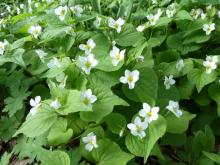
Re: Which viola is this?
I don't know that species but I know violets can be difficult to name. You have to look at how it branches, where the leaves are attached to the stem and so forth.
Re: Which viola is this?
Looks like Viola striata to me -
Re: Which viola is this?
Does seem likely to be V. canadensis. In the USDA Plant Profile pages, they recognize 4 varieties, those that occur in Western Canada would be V. canadensis var. rugulosa.
Viola canadensis, 4 varieties in USDA Plant Profiles
http://plants.usda.gov/java/profile?symbol=VICA4
Calphotos
http://calphotos.berkeley.edu/cgi/img_query?query_src=photos_index&where...
Burke Museum of Natural History
http://biology.burke.washington.edu/herbarium/imagecollection.php?Genus=...
E-Flora BC, V. canadensis var. rugulosa
http://linnet.geog.ubc.ca/Atlas/Atlas.aspx?sciname=Viola%20canadensis
I scanned a line drawing of V. canadensis from Violets of North America by Erza Brainerd, Vermont Agricultural Experiment Station, December 1921, Bulletin 224.
Someday I'll scan and post some of the fine watercolors and line drawings from this 171 page monograph that precedes Doretta Klaber's book on Violets, some of the drawings are very beautiful. There's a separate volume entitled "Some natural Violet Hybrids of North America" also by Erza Brainerd, 205 pages, published in 1924; there are a staggering number of natural hybrids, which gives me cause to not worry about what violet species I might be looking at ;)
Re: Which viola is this?
Looks like Viola striata to me -
The problem with Viola identification, many are so similar, the taxonomy is extremely confusing, and many (most) species naturally hybridize. The photos of V. striata do look similar, but there are these narrow leafy toothed bracts along the stems, it can be seen in this drawing:
http://wisplants.uwsp.edu/scripts/bigphoto.asp?bigphoto=VIOSTR_.jpg&taxon=Viola%20striata%20Aiton&phog=Botanical%20Illustration&spcode=VIOSTR
...and they can be seen (although blurred) in this photo just to the lower right of the flower:
http://wisplants.uwsp.edu/scripts/bigphoto.asp?bigphoto=VIOSTR_STEELE.jpg&taxon=Viola%20striata%20Aiton&phog=Kyle%20Steele&spcode=VIOSTR
aha, found a page that clearly shows the lanceolate "stipules" or aforementioned toothed bracts along the stem:
http://www.missouriplants.com/Whitealt/Viola_striata_page.html
...and another showing the "stipules":
http://tenn.bio.utk.edu/vascular/database/vascular-photos-enlarge.asp?Ca...
USDA Plant Profile on Viola striata, found in eastern half of the USA:
http://plants.usda.gov/java/profile?symbol=VIST3
Re: Which viola is this?
Just thought I'd show this one, Viola palmata that shows up spontaneously in my yard (at least I think it is V. palmata). Some of the leaf forms are very variable, so I wonder if they might be hybrids. One photo shows flowers in late May, and then one taken in September 2011 showing the rather attractive foliage and cleistogamous-produced seed pods opening. The day after I took the foliage photo, it was eaten to a stub by rabbits, they adore violets, thus the near total decline of many forms of V. pedata I once had.
Re: Which viola is this?
Be glad, be very glad, the rabbits ate the violet. From the pictures, it is V. palmata. I have it and it is one of my worst weeds. Every little bit of rhizome sprouts.... every seed germinates.... OK, it's a pretty flower, but enough already! Can I borrow a rabbit?
I've had V. palmata natively in my yard for the 24 years I've lived here; I almost never have problems with rabbits but the last few years there's been a couple rabbits around and a woodchuck family. In all those years this violet has barely spread at all even though it does set lots of seed, just here and there the plant pops up and I always welcome them. One person's weed (in a given climate) may be another person's delight in a different climate. By the way, if I could loan you my wild rabbits, I'm happy to do so ;)
Re: Which viola is this?
Here's a cute little violet species that I took photos of in a graveyard in Templeton, MA (central Massachusetts) back in May 2011. The graveyard had beautiful swathes of Phlox subulata, wide attractive patches of a short-stemmed dioecious Antennaria in both male and female forms, and just a few individuals of this little rosette-shaped viola. Anyone know what violet species it is?
Re: Which viola is this?
Can't help you Mark! The most similar species I am familiar with is this one, Viola rupestris:
Re: Which viola is this?
Looks like V. fimbriatula, Ovate-leaved Violet. It's a lovely plant - blooms again in the Fall, here, and never spreads. It likes rock garden conditions, too! Full sun and good drainage and it's happy.
Thanks Lis, you know your violets! I'll go look up that species in Klaber's book and my old but revered monographs on American Viola by Erza Brainerd, it's obvious that I don't study the books enough! Glad to hear this one is not invasive for you. Maybe next spring when I visit Karen Perkin's Garden Vision Epimediums nursery in Templeton MA, I'll see if I can find a small seedling or two to try.
Re: Which viola is this?
Thanks, everyone, for all the information. I intended to check on the stem/leaf arrangement (as per Lis' and Hoy's advice) but unfortunately, it will have to wait for spring now, as the plant was pretty much stomped into oblivion by the efforts to cut down and eventually remove some old roses in that area. I have the sense that it is likely V. odorata, though, as Lis suggested, from the general look of it (both stems and leaf shape) and will try to confirm it in spring.
Re: Which viola is this?
If it is Viola odorata certainly you will know for sure in spring when it blooms ;) Here V. odorata is the very first violet to flower and no other has a scent like it! Later most of the flowers are cleistogamous.




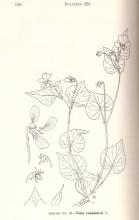
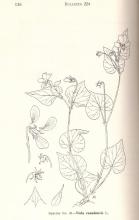
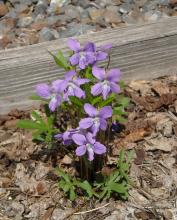
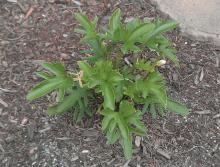
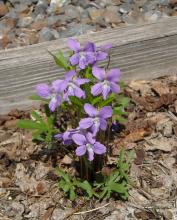
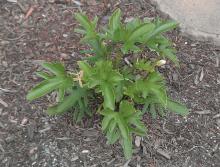

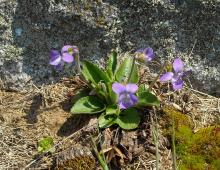
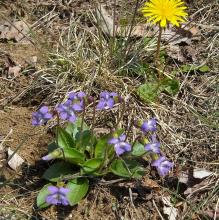


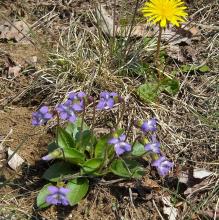
Lori, that looks very much like V. canadensis. Here's a phot link for it...
http://www.bing.com/images/search?q=viola+canadensis&view=detail&id=96CA...